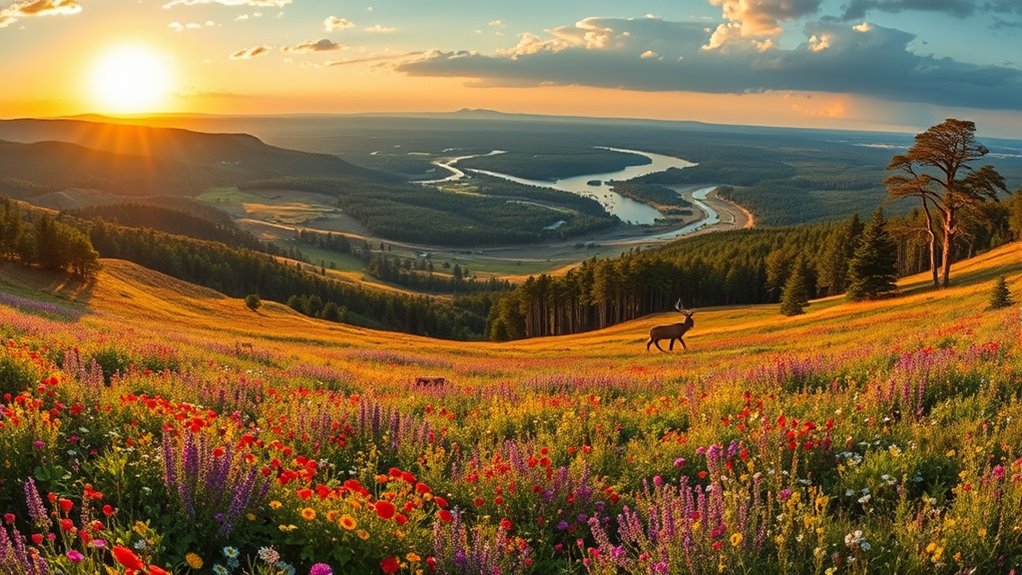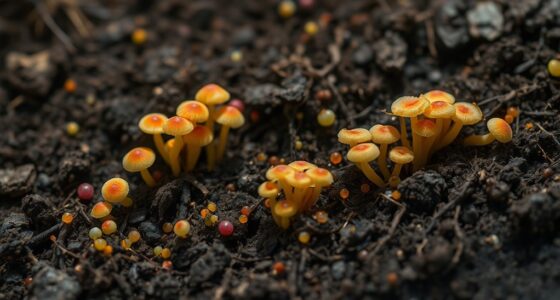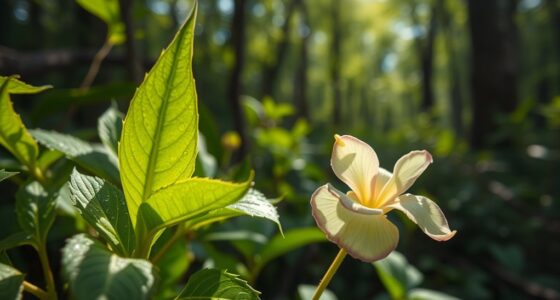Rewilding landscapes helps restore ecosystems by reconnecting habitats, promoting biodiversity, and encouraging natural processes like pollination and seed dispersal. By establishing wildlife corridors and planting native species, you support wildlife movement and resilience. These efforts protect against environmental stresses and prevent land degradation. Embracing innovative tools and community involvement makes rewilding more effective. If you continue exploring, you’ll discover how these steps can truly heal and sustain our natural world.
Key Takeaways
- Rewilding restores ecosystems by reconnecting habitats and promoting ecological processes essential for biodiversity and resilience.
- Establishing wildlife corridors reduces habitat fragmentation, enabling species migration, breeding, and adaptation.
- Restoring native plants supports local food webs, soil health, and water quality, fostering self-sustaining ecosystems.
- Combining native plant restoration with wildlife corridors accelerates ecological recovery and enhances landscape resilience.
- Using digital tools and community participation improves planning, monitoring, and success of rewilding efforts.

Rewilding landscapes offers a powerful way to restore ecosystems and reconnect people with nature. When you focus on rewilding, you’re helping to create environments where wildlife can thrive and ecosystems can heal. One of the most effective strategies is establishing wildlife corridors. These are strips of natural habitat that link isolated patches of wilderness, allowing animals to move freely between them. By creating these corridors, you reduce habitat fragmentation, which often isolates species and decreases their chances of survival. As you implement wildlife corridors, you’re giving animals safe passages for migration, breeding, and foraging, therefore boosting biodiversity and promoting healthier ecosystems. Alongside this, native plant restoration plays a fundamental role. Restoring native plants ensures that the local flora, which many animals depend on, can flourish again. Native plants are adapted to the specific climate and soil conditions of the area, making them more resilient and easier to maintain than non-native species. When you undertake native plant restoration, you’re not just planting trees or shrubs—you’re re-establishing the foundation for entire food webs. This process provides food and shelter for insects, birds, and mammals, which in turn supports the larger ecosystem. It also helps prevent soil erosion and improves water quality by filtering runoff. The combined effort of creating wildlife corridors and restoring native plants accelerates ecosystem recovery, making landscapes more resilient to environmental stresses like climate change and human development. As you work on connecting fragmented habitats with corridors, you’re enabling species to adapt better to changing conditions and to recolonize areas where they once thrived. Native plant restoration enhances this effect by ensuring that the habitat is suitable for local wildlife, creating a self-sustaining environment. Both strategies require careful planning and ongoing management, but the benefits are profound. You’re not only helping individual species but also fostering a balanced, interconnected ecosystem that can sustain itself over time. Rewilding landscapes in this way restores ecological processes—like pollination, seed dispersal, and nutrient cycling—that are essential for long-term health. Incorporating digital tools can further optimize planning and monitoring efforts, leading to more effective restoration outcomes. Using technology in conservation efforts allows for better data collection and analysis, which improves decision-making and resource allocation. It also provides opportunities for community engagement and education about conservation. Community involvement plays a vital role in ensuring the sustainability and success of rewilding projects, as local stakeholders often have valuable knowledge and a vested interest in the landscape. By actively participating in rewilding, whether through planting native species or designing wildlife corridors, you contribute to a broader movement aimed at healing damaged ecosystems. The integration of innovative methods can further enhance these efforts by increasing efficiency and success rates. This approach empowers communities to take ownership of their natural surroundings, ensuring that these vibrant landscapes will continue to support diverse life forms for generations to come. Ultimately, rewilding landscapes isn’t just about restoring nature; it’s about creating a resilient, thriving environment where both wildlife and humans can coexist and flourish.
Frequently Asked Questions
How Do Rewilding Projects Affect Local Communities Economically?
Rewilding projects can bring significant economic benefits to your local community by boosting eco-tourism, creating jobs, and attracting new investments. When you engage your community in these initiatives, you foster a sense of ownership and support, ensuring sustainable growth. By actively participating, you help maximize economic benefits, improve local livelihoods, and promote environmental health, making rewilding a win-win for both nature and your community’s economy.
What Are the Primary Challenges Faced During Rewilding Initiatives?
You face several challenges during rewilding initiatives, including invasive species that threaten native ecosystems. Studies show that invasive species can reduce biodiversity by up to 50%, complicating restoration efforts. Funding constraints also pose significant hurdles, limiting project scope and sustainability. Managing invasive species requires continuous effort, and without adequate funding, efforts to restore ecosystems face setbacks. Overcoming these challenges demands strategic planning, community support, and sustained investment.
How Long Does It Typically Take to See Ecological Benefits?
When wondering how long it takes to see ecological benefits, know that the restoration timeline varies depending on your efforts and environment. You might start noticing improvements in ecological indicators like plant diversity or wildlife return within a few years, but full ecosystem recovery can take decades. Stay patient and monitor progress regularly, as consistent efforts and adaptive management help accelerate positive changes in the landscape.
Can Rewilding Be Implemented in Urban Environments?
Imagine turning your city into a vibrant garden of life. Yes, rewilding can be implemented in urban environments by enhancing green infrastructure and promoting urban biodiversity. You can create green rooftops, pocket parks, and wildlife corridors that serve as urban oases. These efforts reconnect humans with nature, helping ecosystems thrive right outside your door. Rewilding in cities restores balance and transforms concrete jungles into thriving habitats.
What Role Do Private Landowners Play in Rewilding Efforts?
As a landowner, you play a vital role in rewilding efforts through landowner engagement. Your participation helps restore natural habitats and supports biodiversity. By taking advantage of conservation incentives, you can make rewilding financially feasible and attractive. Your commitment not only benefits local ecosystems but also promotes sustainable land use practices. Ultimately, your active involvement can drive meaningful change and contribute to the broader success of rewilding initiatives.
Conclusion
As you watch the rewilded landscapes come alive, imagine rivers carving new paths through lush, untamed woods, and animals roaming freely across open plains. Your efforts help restore these vibrant scenes, turning fractured lands into thriving ecosystems. With each step you take toward rewilding, you breathe life back into nature’s canvas, witnessing a breathtaking symphony of growth and renewal. Together, you’re helping create a wild, beautiful future where nature can heal itself and flourish once more.










